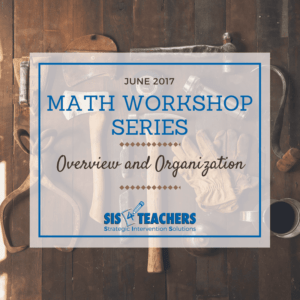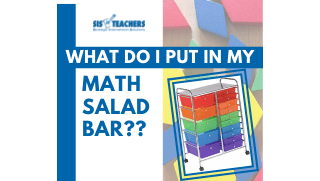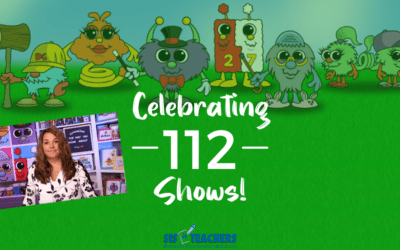You’ve prepared, copied, pulled manipulatives and packed the dish-tubs for your math centers, and the result is Pinterest-worthy (nobody has to know how long it actually took!!). You know what is going to happen now, don’t you? As soon as you sit down with your guided math group, someone will say, “Miss! I don’t have a die!” or “Miss, I don’t have the cards for this game!” You’ll say, “It’s there in the green tub under the window by the pencil sharpener…never mind, let me just get it…” You get the students what they need, but you lose time in your guided math group while you try and manage all the stations. If this sounds like your math block, math workshop might be for you!
 We get a lot of questions from teachers about how we set up, organize, and run a math workshop. As we wrap up this school year and you start thinking ahead to the fall, the summer is the best time to set up a math workshop because you will actually have the time to things the way you’d like them to be. Over the next few weeks, we will be presenting a series of posts on the math workshop. Today’s post will be an overview of the math workshop and focus on the set up and organizing, and then subsequent weeks will go more in-depth into each of the different components. Along the way, we’ll throw in some great free printables, practical ideas and suggestions, and we hope this will be a great resource for you!
We get a lot of questions from teachers about how we set up, organize, and run a math workshop. As we wrap up this school year and you start thinking ahead to the fall, the summer is the best time to set up a math workshop because you will actually have the time to things the way you’d like them to be. Over the next few weeks, we will be presenting a series of posts on the math workshop. Today’s post will be an overview of the math workshop and focus on the set up and organizing, and then subsequent weeks will go more in-depth into each of the different components. Along the way, we’ll throw in some great free printables, practical ideas and suggestions, and we hope this will be a great resource for you!
Getting Started
I recommend taking a full four weeks to introduce math workshop because just like with anything else you are introducing, if you try to get through it faster, it doesn’t usually stick the way you want it to.
What we are outlining is one way of doing math workshop. There isn’t just one right way. The classrooms in our project schools use this way as the basis for their math workshop, but you tweak it and can make it work for you and your classroom.
I typically recommend grouping the students by ability. This allows you to be more focused when you’re leading a guided math group. For the Math with Someone station, I find that I can differentiate the games available at the station, so it works well for the students to find and play a game with someone at their same level.
 When you create your teams, you can color code students on the team. For example, Sherry and Shannon are math buddies, so their names are written in a specific font or color within that team. Joey and William are also on that team, and they’re going to be math buddies so they’re in a different font or color as well. This helps for a few reasons. First, students know exactly who they will be partnered with for games in Math with Someone. Second, when they have a question or run into a problem in Math with Tech or Writing, their buddy is the first person they’ll ask (instead of interrupting the teacher!).
When you create your teams, you can color code students on the team. For example, Sherry and Shannon are math buddies, so their names are written in a specific font or color within that team. Joey and William are also on that team, and they’re going to be math buddies so they’re in a different font or color as well. This helps for a few reasons. First, students know exactly who they will be partnered with for games in Math with Someone. Second, when they have a question or run into a problem in Math with Tech or Writing, their buddy is the first person they’ll ask (instead of interrupting the teacher!).
You can certainly display your rotations on the smartboard, but don’t leave it up for the whole math workshop. You don’t want your smartboard to become a glorified whiteboard and your students should be developing the responsibility of moving themselves through the stations. Additionally, your guided math group would really benefit more from being in front of the whiteboard with you, using the interactive tools it offers.
For our math workshop, we’ve gone to a cut-out look, something that can be laminated, cut out and put on the wall, leaving your technology free to be used within a station. Download our free Guided Math Workshop organizational documents to get started!
Math Workshop Structure
The math block usually starts with 7-10 minutes of a number talk, then (depending on the grade level) we’ll go into an application problem/mini-lesson. The rest of the time will be set up in four stations: Math with a Teacher, Math with Someone, Math by Myself, Math with Writing/Tools/Tech. Depending on how many students you have and how much time you have allotted for math, you could also do three stations. You’ll divide the students into the same number of groups that you have stations. If you are new to math workshop, you might start by eliminating the Math with a Teacher station, making that part more of a whole-class lesson before the students move into the other three stations. You can still pull students in a small group to work on something, but we encourage you not to pull students from the Math with Someone group! Often the games don’t work when your “someone” is gone!
I typically like to start my most at-risk group of students in the Math with a Teacher station and my higher-level students have the Math with a Teacher station last. I also like to have the students move from the Math with a Teacher station straight into the Math by Myself station because it’s a seamless connection from what you are doing in the guided math lesson into independent practice. Sometimes, I’ll even get my at-risk groups started in the independent practice at the end of their time in my station, getting them ready for what they’ll be doing when they’re in the Math by Myself station.
 In K-1 classrooms, we have students visit a Math with Tools/Tech station and do tool exploration or use iPads or Chromebooks on apps or math websites. In upper grades, 2nd up, we drop tool exploration and go more into technology or writing, all of which are based on problem solving (not fact practice – we’ll get into this more in a later blog post!).
In K-1 classrooms, we have students visit a Math with Tools/Tech station and do tool exploration or use iPads or Chromebooks on apps or math websites. In upper grades, 2nd up, we drop tool exploration and go more into technology or writing, all of which are based on problem solving (not fact practice – we’ll get into this more in a later blog post!).
One of our biggest goals in implementing the math workshop is to produce independent learners. We want to empower students to make choices and have responsibilities in each station. They will receive an activity card that outlines exactly what they need to bring to each station (for example, whiteboard, marker and journal for Math with a Teacher) and they are responsible to be prepared for that station. In Math with Someone, I usually offer a few choices for games they can play. They’ll select their activity card with the name of the game, and then go the Math Salad Bar (a cart of centrally located materials), grab a bowl, and fill it up with the ingredients they’ll need to play. You’ll just need to decide where you want the cards to go. Pocket Chart showing students where they’ll be in various rounds are popular, and it’s easy for teachers to look at the chart and see where everyone is.
In Kindergarten, it might take students a while to work up to that level of responsibility, so you might start out with the tubs and gradually work up to students getting their own materials over the course of the year.



